1963 German Grand Prix race report: Surtees rules at the 'Ring
John Surtees claims his debut win and Ferrari's first for two years; Jim Clark and Richie Ginther fill out the podium
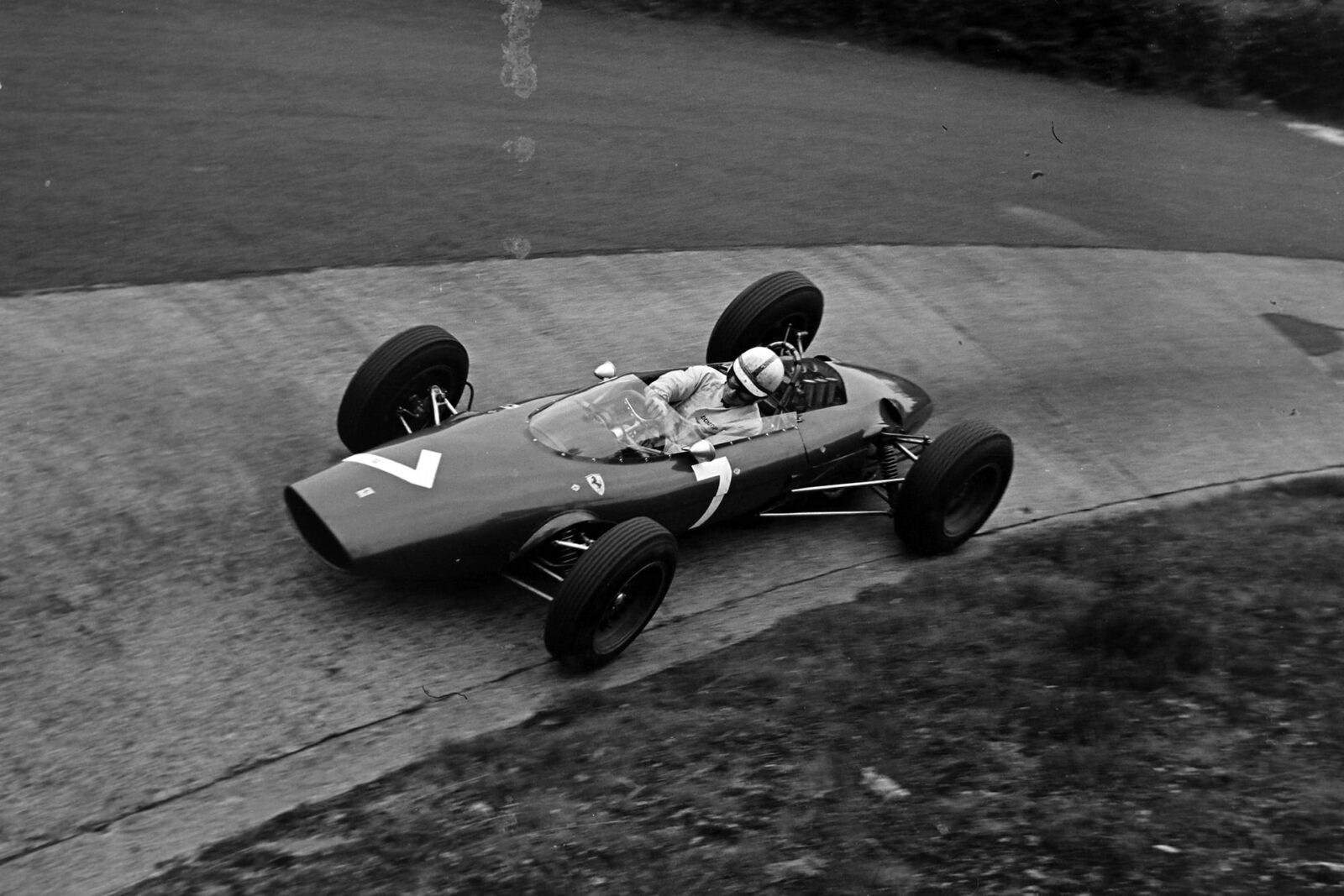
Surtees took his debut win at the Nurburgring
Motorsport Images
As if to celebrate the 25th German Grand Prix the weather at the Nurburgring in the Eifel mountains almost behaved itself for the duration of the meeting, which covered practice on Friday and Saturday and the race on Sunday. On such a long circuit with a change in height between the start area and Breidscheid of many hundreds of feet, and hills and valleys where it can be raining in one valley and not in the next, the weather plays an important part.
The “ice-age” of last winter had played havoc with many parts of the course, not in large visible bumps, for last May at the 1,000 kilometre race the heavy GT cars were not troubled, but in a general roughness that caused the light Grand Prix cars to be on tip-toe in a lot of places. Any natural hump that normally made them rise or fall to the limits of their suspensions was now making them become airborne or making suspensions hit the bump stops. Observation round the circuit during practice made this very obvious, for wheels were pattering visibly and many inches of daylight could be seen under the wheels in all sorts of unlikely places.
“The “ice-age” of last winter had played havoc with many parts of the course”
Eighteen entries were accepted from works teams, private teams, and good private owners, and eleven extra entries were given to drivers or teams who had yet to prove themselves or were of known dubious potential as serious Grand Prix competitors. The selected eighteen comprised the BRM works team, Team Lotus, the Cooper works team, the Scuderia Ferrari, the Brabham team, the ATS team, Ireland with the BRP car, Bandini with the Centro-Sud BRM, Bonnier with Walker’s Cooper-Climax V8, de Beaufort with his Porsche, Joseph Siffert with his Lotus-BRM V8 and Masten Gregory with Tim Parnell’s Lotus-BRM V8.
The BRM team had Graham Hill with the new stressed-skin car and one of the earlier cars as a stand-by, and Ginther with his regular 1962/3 car. The 1963 car had been improved in various ways, notably by a stiffening of the front arm of the lower front wishbones, this being done by welding a second tube along the length of the existing one. Also the oil radiator was relocated, being at the front in a more normal position, while the “nightmare” of British Grand Prix cars, the Lucas transistor box for the ignition, was now mounted higher behind the driver’s head so that it was in the air-stream.
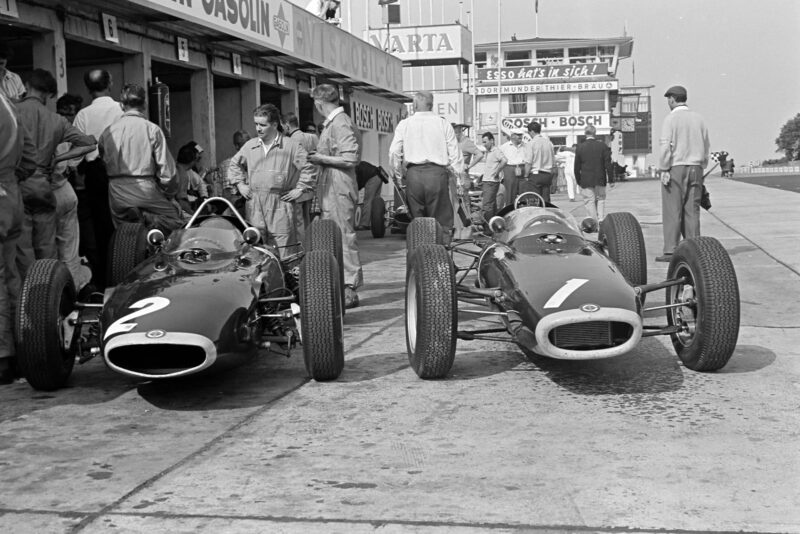
BRM brought their new car for Hill (right), whilst Ginther used their ’62 model (left)
Motorsport Images
A rudimentary anti-crash bar ran over the top of this (as if BRM had read our caption of last month?), though like most Grand Prix cars it still did not comply with the FIA regulations. The air-intakes let into the engine hatch previously were now replaced by air scoops on either side, to take air to the Lucas fuel injection trumpets. Ginther’s car had various stiffening gussets welded into the frame and suspension at the front in search of more rigidity, and both this car and Hill’s earlier one were using BRM 6-speed gearboxes.
The Bourne team were at Nurburgring early and did a lot of pre-race testing. Team Lotus travelled directly from Stuttgart, where they had been racing the previous weekend, and Clark retained the same car he had used there to do his series of record laps, and Taylor was back on the Lotus 25 with Colotti gearbox, both cars having the “air-stream” windscreens.
The Cooper works team of McLaren and Maggs were as raced at Silverstone, John Cooper not being in attendance as he was still not fully recovered from his accident, so Ken Tyrell was running the team.
The Scuderia Ferrari were back to full strength, with Surtees and Mairesse, the Belgian being recovered from his Le Mans accident. The two V6-engined cars were basically as before, but the car Surtees was driving was fitted with bolt-on wheels in place of the usual knock-off hubs which were fitted to Mairesse’s car. These were still the Ferrari cast wheels, with pin-drive but the method of fixing had at last followed the trend set by Lotus and Cooper many years ago. It was obviously a great moment when Ferrari threw wire-wheels over the hedge, but to follow this by throwing eared hub-nuts after them must have caused a lot of heart-searching in Maranello.
Who knows, Enzo may one day discover about 10mm sparking plugs, for at the moment he is still the last haven of 14mm plugs in Grand Prix racing. Endeavours have been made to keep the air temperature down at the intake trumpets, first by shrouding the six inlets with an aluminium shield to keep engine heat away, and now the inboard rear brakes were fitted with shrouds to deflect the generated heat downwards, as previously it was being thrown up into the vee of the engine and warming the injection pump abnormally. The engine hatch was fitted with a single-piece wire gauze cover over the intake trumpets, which resulted in a lower tail line.
After his win at Solitude Brabham’s mechanics removed the Coventry-Climax V8 engine and when they got to Nurburgring they met the remainder of the team with Brabham’s newest Grand Prix chassis, with the VW-Hewland gearbox, and installed the Solitude engine into it. Gurney’s car was as used at Silverstone, except that he was back on an earlier injection Coventry-Climax engine, the only usable part salvaged from his blow-up with the single-plane crank engine being a cylinder head.
The ATS team was to have been Phil Hill and Baghetti, but they were still learning about racing the hard way, for this time the transporter ran out of road on its way through Austria and the cars fell off and were damaged. At some time or other all teams suffer this sort of misfortune, brought about by lateness, or tiredness on the part of the mechanics, and when this news reached Nurburgring many mechanics in teams now well organised thought back to their early days when they were learning the hard way that there is more to racing than building a car or paying a top-driver.
The BRP team’s entry in the invited list was for Innes Ireland and the car was their own stressed-skin car as it had finished at Solitude, and though Ireland was in better spirits he was inwardly convinced that Nurburgring was against him, having so far chalked up a tale of misery at every visit.
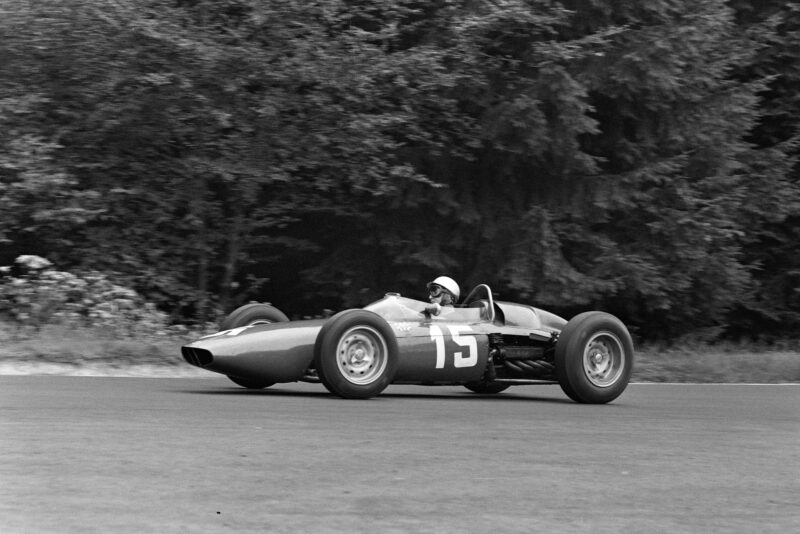
Bandini was driving a Centro Sud-entered BRM
Motorsport Images
The BRM works mechanics were still looking after the red-painted 1962 car for Bandini and Centro-Sud, well pleased with their Italian driver after his performance at Solitude, and he with them and the car. The Rob Walker team were well organised, the mechanics taking the 1962 car, with its broken engine suffered at Solitude, to Ostend where it was sent back to England, and there receiving the 1963 car repaired after the Silverstone blow-up, and returning with it to Nurburgring for Bonnier to drive.
No greater tribute could be paid to those two regular and serious-minded private owners, Godin de Beaufort and Joseph Siffert, than to give them selected entry for the German Grand Prix, on an equal with all the works teams; the big Dutchman with his 4-cylinder Porsche and Siffert with his Lotus-BRM. The young Swiss driver and his mechanics had done a monumental piece of organising and hard work after the Solitude race where the engine blew-up and the gearbox gave trouble.
One mechanic had flown to England with the engine and gone to Bourne and repaired it, another had flown to Italy and gone to Modena to have the Colotti box overhauled, the third had stayed at Stuttgart and got the chassis cleaned and checked over, and they had all met again in the paddock at Nurburgring and assembled the car and had it ready for the first practice period. Siffert and his little band are a model of determination and dedication that many could follow. The last selected entry was for Masten Gregory and he was to have driven a borrowed car but it was unserviceable so the entry was scrubbed.
Of the miscellaneous eleven extra entries the fastest six in practice were to start, but with Gregory’s withdrawal this was increased to seven. They comprised Jim Hall with the BRP entered Lotus-BRM V8, his performances although steady this season have not shown much serious improvement; Chris Amon with Parnell’s Lola-Climax V8, the driver having good potential but the reliability of the car not being outstanding; Mario Cabral the Portuguese driver being comparatively inexperienced, though he now had a brand new 1962 Cooper-Climax V8, it being a third works car from last season that was never completed at the time, the entry being made by the Scuderia Centro-Sud; the Scirocco-Powell team of Scirocco-BRM V8 cars with Settember and Burgess, neither cars nor drivers having yet proved themselves on speed or reliability; Ian Raby who took over Abate’s entry at the last moment, driving his Gilby-BRM V8; Gerhard Mitter driving de Beaufort’s second Porsche 4-cylinder; Kuhnke with his unknown Lotus-Borgward; Pilette and Tim Parnell with old 4-cylinder Lotus-Climax cars, and Collomb with his Lotus-Climax V8.
Qualifying
On the Friday morning there was one and a half hours of practice, which is not very much on a 22.8-kilometre circuit, on which each lap takes more out of a car than a whole race at some of our little circuits in Britain. Jim Clark was first away, using the Lotus just as it came from Solitude, though a brand-new engine was awaiting him in the paddock. On his very first lap Ireland got into a slide with the BRP-BRM and spun off into the undergrowth, putting a nasty dent in the right-hand side of the chassis/body unit, and bending some of the suspension parts. He managed to get it back to the pits, and luckily BRP had his Lotus-BRM V8 on hand so he was able to use that for the rest of practice.
Graham Hill started off in the 1963 BRM but was soon back and using the older car, which did not encourage the BRM team very much. Chris Amon was awaiting the return of his engine from Coventry, so in the meantime he went out in the Lola that Hailwood had driven at Solitude the previous weekend, but had not gone far before a big-end bearing went.
A lot of drivers were out but not many did consecutive laps, most of them being content with a single one at a time. However, Mitter was going round very neatly and steadily, and Bandini was looking fast and confident, while Mairesse seemed well back on form. This first session was a try-out for most people, and only Surtees and Bandini were able to get below the 9min mark for a lap, the Ferrari driver being out to make the most of this circuit where driving and knowledge is worth many horsepowers, and where adaptation of the handling to the conditions is all important. In view of the tendency for the Grand Prix cars to become airborne Surtees was getting the Ferrari team to concentrate on spring-rates and shock-absorber settings that would keep the car on the ground as much as possible, even if it meant that it did not handle to his liking on some of the corners.

Privateer Bandini surprised many by lapping 2nd fastest in his BRM early on
Motorsport Images
The lap record for the circuit was set up in 1961 by Phil Hill (Ferrari) with a time of 8min 57.8sec, and last year in practice Gurney (Porsche 8cyl) did 8min 47.2sec, but race day was so wet that no records were possible. The whole front row on that occasion were faster than the record lap, so with the weather set fine and clear the works drivers could all anticipate laps in under 9min when they got truly wound-up. Surtees did a lap in 8min 46.7sec which not only showed that the Ferrari was competitive, but indicated just how seriously he was getting on with the job of driving. Bandini did 8min 59.3sec which was second fastest, he also getting on with the job of driving and not worrying too much about handling or technicalities. As the practice-time table shows, the fast runners were settling in, the slow runners were slow and the hopeless runners were as hopeless as ever.
After lunch there was another hour and a half of practice, and everyone was set to have a bit of a go, either to catch Surtees who was setting the pace, or to wipe off the smiles that were on many faces due to Bandini having lapped faster than the BRM works team, and all the other highly-paid “stars of the universe!” Unfortunately the Eifel weather lost interest in this being the Jubilee year of the German Grand Prix and a few scattered showers drifted about the mountains and dropped here and there in an unpredictable manner so that all hopes of fast laps were gone before practice started again.
Hill was about to go out in the old BRM when the oil pressure showed signs of sagging and investigation showed that it was a tiny piece of dirt under the pressure relief valve, but during the investigation a jet of hot oil came out of the works that made it look as though BRM had “struck oil.” Meanwhile Hill had gone off in the 1963 car, but it was beginning to look as though it was going to be relegated to training only. Clark’s Lotus was showing signs of getting tired, his ten meteoric laps at Solitude having taken the edge off the engine, and he was having to use 6.00 x 15in tyres on the back to get it up to maximum rpm.
The damp parts of the circuit discouraged much effort in the way of practice, but even so some people were in trouble, McLaren’s Cooper engine sounding rough, and when the exhaust pipes were taken off a valve-head fell out! The ATS team had still not arrived, and the Scirocco team were still being prepared in the paddock. It was interesting that the rain put almost exactly a whole minute on to the lap times of the faster drivers, Clark being best with 9min 44.0sec, and Surtees next with 9min 46.6sec. Some portent of what was to come could be seen from Ginther doing 9min 55.0sec, Bonnier 9min 58.6sec. and Siffert 9min 59.3sec.
During the evening the paddock was very busy, with Ferraris putting another engine into Surtees’ car, Clark having a new Climax V8 put into his Lotus, together with a new ZF gearbox from which reverse gear had been left out in order to avoid any possible trouble with selectors as the reverse-gear selectors are on the same shaft as the forward gear selectors and can cause trouble; Coopers were putting another engine into McLaren’s car; and sorting out the gearbox on Cabral’s car, and the Scirocco cars were at last made ready.
Saturday morning was fine and dry and everyone was out for a final fling under good conditions. The ATS cars had arrived and the mechanics were trying to make one good one out of the two, in order to get Phil Hill out for practice. The front suspensions had been redesigned, the principle being the same, but the manufacture looking much more permanent, and there was a general air of everything being much tidier and a lot less temporary and hastily made. The engine in Hill’s car was fitted with Lucas fuel-injection, but after troubles with brakes and fuel tanks the engine was reluctant to start and time ran out on them so that there was no hope of practice. As the AVD would not permit them to start without practice there was no alternative but to pack up and go back home, bitterly disappointed and cheated through no fault of the cars themselves.
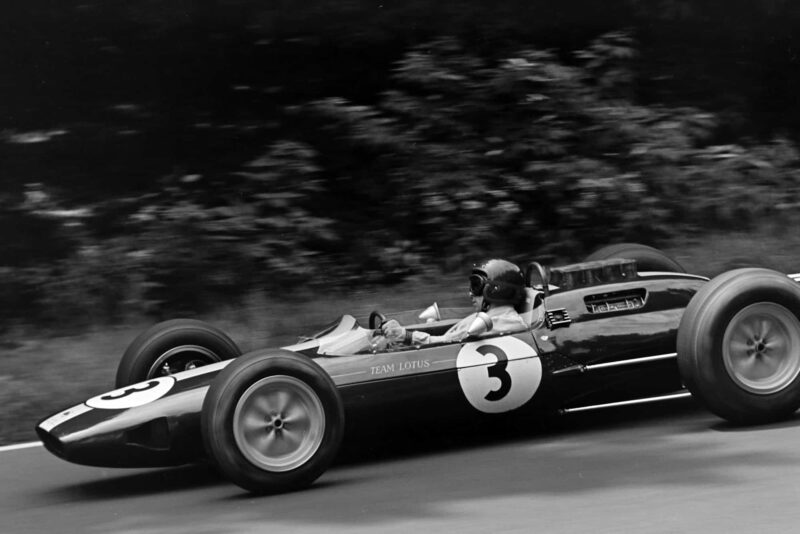
Clark took a fifth pole of 1963
Motorsport Images
Observing at a fast downhill and bumpy section, Surtees, Clark, Bandini, McLaren and Graham Hill were really travelling, and it was no surprise to find they were officially the fastest. Watching at half a dozen different corners, and seeing them all on the limit all the time, it was reasonable to assume that they were driving like that all round the circuit. Equally, some drivers came by looking as though they had no idea where they were going, and their lap times confirmed this.
“Observing at a fast downhill and bumpy section, Surtees, Clark, Bandini, McLaren and Graham Hill were really travelling, and it was no surprise to find they were officially the fastest”
McLaren went by very slowly, limping back to the pits, having had the lower right-hand front wishbone break which gave him a nasty moment, and many cars were grounding on some of the bumps. Surtees had his chassis crack, and Clark’s new engine and gearbox were working well. Taylor was having a miserable time once more with the second Team Lotus car, the Colotti gearbox seeming to give trouble the moment he touched the gear-lever. Amon was getting in some much needed practice, now having his new engine fitted to his own car, and he was showing that time spent circulating in a private-car earlier in the week was paying off.
Clark made fastest lap in 8min 45.8sec, Surtees did not improve on his time of the first practice session, but was still second and Bandini did a terrific 8min 54.3sec, which made him third fastest ahead of the works BRM drivers and a whole host of acknowledged top drivers. This was no fluke, but the result of enthusiasm and the spirit to press-on and get cracking. Watching him out on the circuit it was noticeable how he knew where he was going and was driving with great force, concentrating on the circuit and not worrying about too much oversteer, too much understeer, wrong shock-absorber settings, or wrong gear ratios or other technicalities.
The challenge to Bandini was obviously the circuit and all its corners, and he was using all the BRM had got and dealing with situations as they arose. Another praiseworthy effort was that of Siffert, who got round in 9min 11.1sec, which put him well among the works runners.
Although work for the drivers stopped at 12:30 on Saturday morning, it then began for the mechanics, and all round the well-equipped paddock there was a lot of overtime being done. Ferraris had to remove the engine from Surtees’ car in order to weld the chassis frame just behind the cockpit, Lotus were removing the Colotti gearbox from Taylor’s car and fitting a ZF in its place, though this was not as easy as it sounded, Cooper’s were bronze-welding stiffening plates to all the front wishbones, BRP were putting another engine into Ireland’s Lotus, the stressed-skin car being out of action after its crash.
Bandini’s BRM was having a thorough check-over of its engine and chassis, the work it had been doing being shown in the way suspension and steering ball-joints had been reaching the limit of their movement, and mingled with all this work were GT cars being prepared for the race that was to open proceedings on race day.
A large, but not astronomical, crowd poured into Adenau and the surroundings and all the wonderful vantage points around the circuit filled up during Sunday morning when the race for GT cars from 1,000cc to 2,500cc was held. To celebrate the jubilee of the German Grand Prix there was a parade of past winners, including Fangio, Moss, Brooks, Chiron, Graham Hill and Bonnier, accompanied by three celebrated team-managers, Neubauer, Ugolini and von Hanstein, and this parade was led by 88-year-old Carl Joens driving a 1913 Opel Grand Prix car, which he did remarkably well for one of such an advanced age.
Race
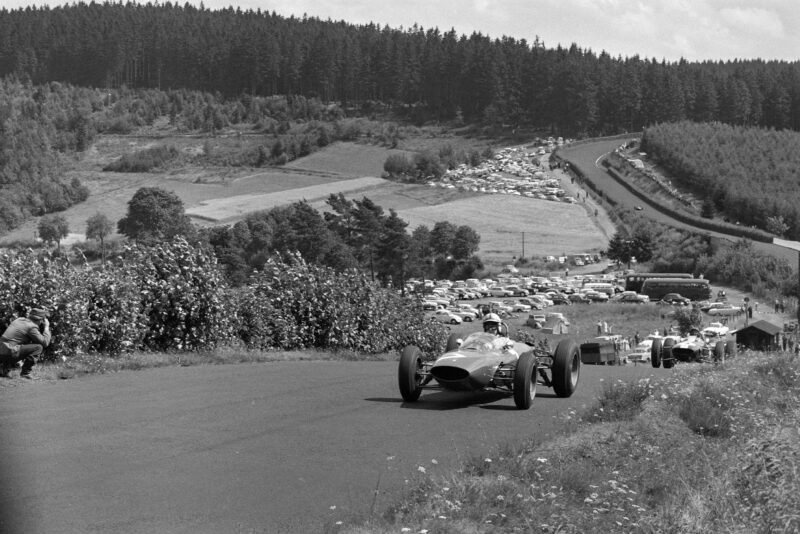
Surtees leads Clark at the start
Motorsport Magazine
It was warm and dry when 22 starters prepared themselves at the pits and the sun was shining as they formed up on the grid in rows of four-three-four. Graham Hill was driving the earlier BRM, both Team Lotus cars had the “air-stream” windscreens, and Ireland was driving a Lotus 24 with BRM engine. As the flag was raised to start the 15-lap race there was a mild panic to one side of the grid as it was seen that Brabham could not get his engine to fire, though the starter was turning it round fast enough to generate 60lb/sq in. oil pressure. The Lucas transistor box had died and as the flag fell he was left on the line, together with Burgess whose Scirocco had also failed to start, as twenty of the runners roared away, Bandini and Surtees on the front row making very poor starts and getting passed on all sides.
Clark leapt into the lead and looked all set to perform another “start-to-finish” domination, but along behind the pits it was seen that Ginther and Maggs were already gaining back ground on the Lotus, which indicated that all was not well. Down the twists and turns to Adenau, where Clark should have got well away Ginther caught and passed him, and Surtees was soon up with him after his hesitant start.
“Bandini was being held up by Ireland and as they arrived at the wide right-hand hairpin leading up to the Karussel, the Italian shot past on braking, overdid things and spun”
Bandini was being held up by Ireland and as they arrived at the wide right-hand hairpin leading up to the Karussel, the Italian shot past on braking, overdid things and spun. Ireland dodged, but the BRM flicked round the wrong way and the two cars collided, the red car being left derelict by the roadside and Ireland limping back to the pits with bent rear suspension.
Meanwhile Brabham’s mechanics pushed him to the pits and set about fitting another transistor-box and Burgess was also wheeled to the pits, where after a short while his car fired on the starter and he started the race. The leaders had nearly completed the opening lap before Brabham got away, and as he disappeared down to Hatzenbach, Ginther led a bunch of cars over the brow from Tiergarten. This group comprised Ginther, Surtees, Clark, McLaren and Hill, and they were so close after this opening lap that all seemed set for a really good battle. Some way behind and spread out came Maggs, Mairesse, Bonnier, Taylor, Amon and Siffert, with the rest following. Gurney came into the pits, his Brabham not running properly and Ireland arrived to retire and explain what had happened to Bandini.
The group at the front did not last long for on the second lap Surtees and Clark got away from them and went ahead on their own, and going over the hump at Flugplatz Mairesse became too airborne and landed off line, which pitched him all over the place and into the ditch, writing off the car and putting him back into hospital with arm injuries.
Bonnier was just behind and had an uncomfortable view of it all, and on the next lap a few hundred yards further on Amon had something break in the steering of his Lola and spun at very high speed, bouncing off the protective hedges and coming to rest in a shower of dust and shrubbery, with a damaged knee and a wrecked motorcar. Once again Bonnier was just behind and saw it all happen!
On this same lap Hill had stopped by the wayside just round the North Curve, with a broken gearbox, so the situation was now Surtees and Clark very close together, the Ferrari driver on top of his form and giving Clark a run for his money, but the Lotus was far from well, as it was cutting out on one cylinder every now and then. Time and again Clark would get by the Ferrari, only to pop and bang onto seven cylinders for a moment, and this was all that Surtees needed to get back in front again.
On the fourth lap Clark actually led across the finishing line, but not for long and Surtees was soon back in front, and on this lap McLaren, who was in third place, had a breakage in a vital chassis part somewhere, on a long fast left-hand curve leading to Aremberg, and this sent him off the road to crash heavily, knocking himself unconscious but getting away comparatively lightly. This put Ginther into third place, followed by Maggs, but they were both a long way behind the leading pair.
Then came Siffert, who had displaced Bonnier, but after seeing two lurid accidents it is not surprising that the Swedish driver eased up a bit, and behind them came the two orange Porsches of de Beaufort and Mitter. Right at the back of the field was Taylor, who had come into the pits to see if his car could be made to go any better, and Burgess who had lost so much time at the start. The Brabham team were in dreadful trouble, Brabham being now a lap behind, and Gurney being in and out of the pits with an engine that would not perform properly in spite of having all possible electrical accessories changed.

Barabham found himself lapped after only four laps
Motorsport Images
As the two leaders went by the pits at the end of the fifth lap, with Clark just holding on to the Ferrari, the Lotus driver was urging his car along like a jockey to indicate to his pit-staff that “it just would not go,” but Surtees was not worried and pressed on to good effect, making the most of a golden opportunity. Previously when Clark has had a car that was not on form he has managed to out-drive everyone in spite of it, but this time it was different and no one was going to out-drive Surtees and the Ferrari was sounding very healthy. Clark was doing all he knew and thrashing the Lotus unmercifully, but the result was only that he could keep up with the Ferrari and he was not sure how long it could go on.
“Clark was doing all he knew and thrashing the Lotus unmercifully”
Retirements were still coming thick and fast, Settember having spun off the road and gone through the wire protecting fence, luckily without injury to anyone, Burgess had skated to rest when his steering broke, and Cabral had gone out with a broken gearbox, while Gurney gave up the unequal struggle when a locking nut came adrift in the gearbox of his Brabham. On the seventh lap Clark’s engine began to misfire even more and he dropped back considerably, being 5sec behind the leading Ferrari, and during the next lap he lost another second, but to lose only 1sec in 22.8 kilometres with an engine running for most of the time on seven cylinders was no disgrace, especially as Surtees was not hanging about, for on lap nine the Ferrari driver set up a new lap record in 8min 47.0sec, which must have meant that Clark was lapping around 8min 48.0sec. Maggs had dropped a long way behind Ginther as his engine went off tune, and finally he retired at the pits when it lost all its power.
All these retirements had let Siffert up into a well-deserved fourth place, and Mitter had passed de Beaufort and Bonnier, so that the old Porsche was now fifth overall. The only remaining runner on the same lap as the leaders was Jim Hall, and Taylor and Brabham were still running but many miles behind. After Surtees had made his terrific lap record Clark was forced to admit to defeat, his misfire being there all the time, and he eased the pace a little to make sure of finishing second rather than retiring.
Nothing could stop the Ferrari now, and Surtees was complete master of the situation, the gap between him and Clark widening slowly but surely. Ginther was firmly in third place, and a very disappointed Siffert had to let fourth place slip from his grasp when his differential broke up. Bonnier had repassed Mitter so that they were now fourth and fifth, and de Beaufort was worried by a tendency for his car to get a bit out of hand on right-hand bends. Suspecting a hub bearing breaking up he stopped at his pit and told his mechanic to rock the left-hand rear wheel to see if there was any play. There was, so convinced that the bearing was going he roared off again intending to drive carefully on right-hand bends and try and finish. He got just beyond Adenau-Forst and was doing about 100mph when the wheel came off! The “play” had not been the hub but the wheel cracking round the pierced holes in the Porsche disc wheel. He subsided in a flurry of hedge clippings a sadder but wiser Dutchman.
At the end of the 13th lap Surtees had 20sec lead over Clark, and the Lotus was now beginning to make odd rumbling and grinding noises from the rear end as if the gearbox was suffering, so Clark slowed even more. Nearly 2.5min behind Surtees came Ginther who was having to drive with one hand and hold the gear-lever in position with the other as it kept jumping out of gear, which is not only bad for the engine, but bad for the driver on a circuit like the Nurburgring.
Mitter now came by in fourth place, and Bonnier was overdue, the Cooper limping slowly into the pits with something very wrong with the rear end. Inspection showed that a chassis tube was broken and two others were cracked, so that the rear wheels were doing nearly as much steering as the front ones.
With Surtees already well on his way round the 14th lap Bonnier decided to limp on and try and complete another lap as there was still a chance of being in the money. Clark was now 36.5sec behind the Ferrari and for the last lap he slowed down even more as there was no chance of Ginther catching him and he was beginning to wonder if the Lotus was going to hold out. As Surtees finished his 15th and final lap a gentle rain began to fall, just to let us all know we were in the Eifel mountains, but it did not last long and a jubilant Surtees got the chequered flag to win the 25th German Grand Prix in a thoroughly convincing manner.
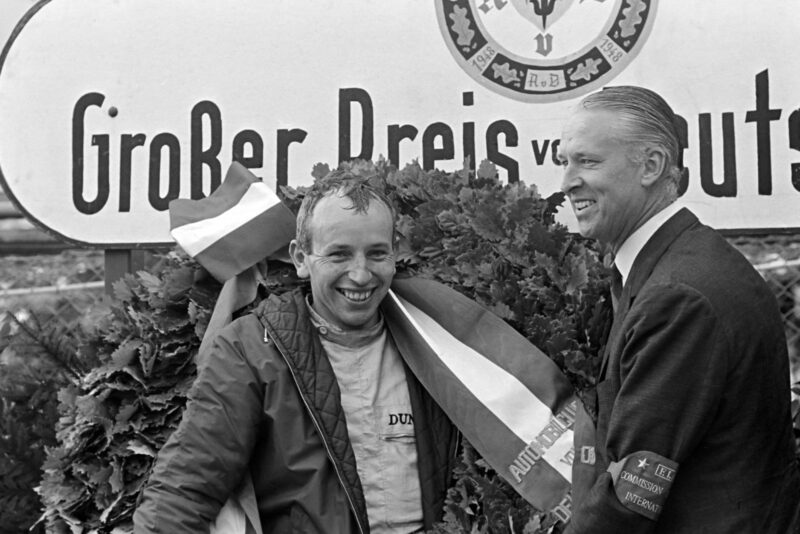
Surtees took a deserved victory
Motorsport Images
Needless to say the Ferrari team were off the ground with excitement, and when Clark finally arrived 1min 17.5sec later to get second place a relieved Team Lotus greeted him, well content with a hard-earned second place. Ginther retained his third place, with blisters on his left hand and a very tired right arm, thankful that the race was over, and a very calm and slightly embarrassed Gerhard Mitter arrived fourth in the old Porsche, having driven an excellent race and having kept on the same lap as the leader. A lap behind came Jim Hall and he was followed by Bonnier who managed to nurse the broken Cooper round for a whole lap, while Brabham and Taylor were also a lap behind.
“Needless to say the Ferrari team were off the ground with excitement”
It was no lucky win for Surtees, for he had shown throughout practice that he and the car were ideally suited to the circuit, and though he viewed the combination of Clark and Lotus as almost unbeatable before the race, he was determined to try and beat it, knowing that all he wanted was a little bit of “luck.” He got it in the form of Clark’s Coventry-Climax engine missing a beat now and then in the opening laps, and that was all he wanted. Had the Lotus picked up on all eight cylinders later in the race it is doubtful whether the result would have been changed, for all Surtees’ laps were near-record ones, his race average of 154.2kph being remarkably close to his lap record of 155.8kph.
